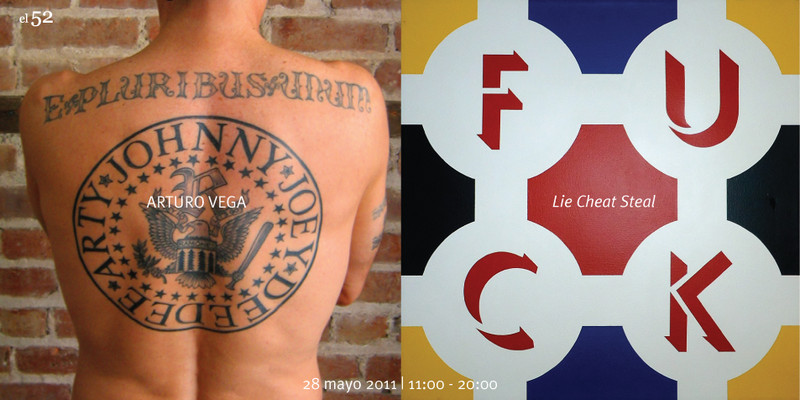Arturo Vega
28 May - 23 Jul 2011
ARTURO VEGA
28 May - 23 July, 2011
El52 presents for the first time after 30 years of production, the artistic work of the artist Arturo Vega. Born in Chihuahua, Mexico, from before the time of color TV, and resident of New York City since the 70’s, his work is influenced by his own life, Rock and Punk.
Arturo Vega was, for 22 years, artistic director, guardian and very close friend to the Ramones, creating not only their logo which later came to be the flag for the punk movement, but also many of their album covers and stage designs. Parallel to this historical music genre that transformed from the fashion to the attitude of its followers, Vega produced a solid body of work that includes paintings using a series of images taken from various media publications as well as fragments of the band lyrics, resulting in pieces that are both mystical and insulting.
Regardless of his strong belief in the revolutionary force of music as it is able to provoke changes in society, in his visual works he is also influenced by the North American pop art. He makes a critique of the human necessity to form a part of capitalist systems, without really considering its consequences. There is something rebellious and seductive in Arturo Vega’s work that defies the social norms, causing people to question ideals and conformities through music, life and art.
28 May - 23 July, 2011
El52 presents for the first time after 30 years of production, the artistic work of the artist Arturo Vega. Born in Chihuahua, Mexico, from before the time of color TV, and resident of New York City since the 70’s, his work is influenced by his own life, Rock and Punk.
Arturo Vega was, for 22 years, artistic director, guardian and very close friend to the Ramones, creating not only their logo which later came to be the flag for the punk movement, but also many of their album covers and stage designs. Parallel to this historical music genre that transformed from the fashion to the attitude of its followers, Vega produced a solid body of work that includes paintings using a series of images taken from various media publications as well as fragments of the band lyrics, resulting in pieces that are both mystical and insulting.
Regardless of his strong belief in the revolutionary force of music as it is able to provoke changes in society, in his visual works he is also influenced by the North American pop art. He makes a critique of the human necessity to form a part of capitalist systems, without really considering its consequences. There is something rebellious and seductive in Arturo Vega’s work that defies the social norms, causing people to question ideals and conformities through music, life and art.

